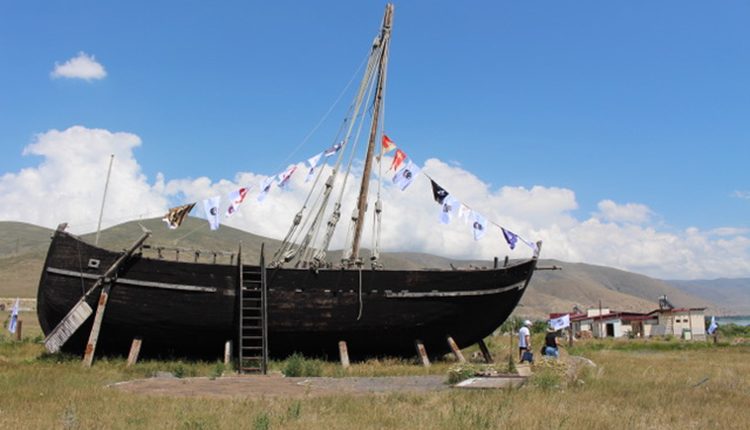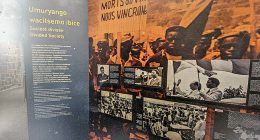By Hovsep Daghdigian
Karen Balayan, born and raised in landlocked Armenia, is a sea captain. He looks the part, and speaks clearly with a calm, assuring voice; all I presume an asset for one who commands a ship and its crew. But besides this, he is a historian and a naval architect. He also may be considered an experimental archaeologist. Experimental archaeologists study the past, striving to replicate the past by living, working, and building as they believe people did long ago. Doing this allows them to verify theories about the past and gain insight about how people lived and thought, and the difficulties they encountered.
Karen (pronounced “Garen” in Western Armenian) was trained as an engineer but had an interest in the sea, initially building model boats and exhibiting them at shows and competitions. His main interest was less in winning awards than introducing Armenian boats to the rest of the world.
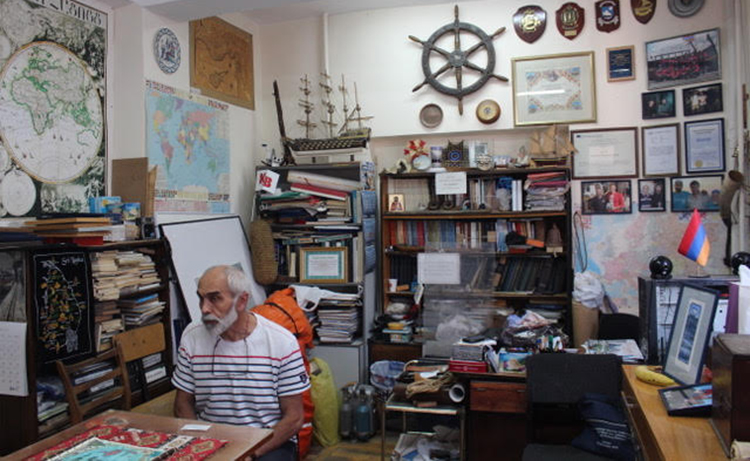

On Armenia’s Lake Sevan he learned to sail small sailboats, later building larger 9-meter sprit-rigged (a type of sail rigging) sailboats and promoting sailing among enthusiastic young Armenians. All the while he researched Armenian nautical history and architecture. Balayan studied ancient boats uncovered at Lchashen on Lake Sevan as well as boats of other nations, but his main focus was on merchant ships of the Armenian Kingdom of Cilicia (12th – 14th c) in the northeast corner of the Mediterranean Sea. This area is currently in Turkey and Syria. In 1985 Karen Balayan and friends founded the Ayas Nautical Research Club (www.ayas.am), with an office in Yerevan currently filled with nautical memorabilia.
This was followed by six years of extensive research on Armenian nautical history, shipbuilding, and navigation techniques at Armenia’s Madenataran (ancient manuscript repository) as well as at archives and museums in Amsterdam, Venice, Genoa, Marseille, Portugal and other ports that documented their medieval trade with Armenian merchants. Many of the traded goods were from Armenia, including Artsakh, while other goods arrived at Armenian Cilician ports from Asia via caravans over the Silk Road. Cargos were then delivered over sea routes by Armenian merchants. In the 13th c shipbuilding skills were passed down from father to son or to apprentices. Now these skills had to be rediscovered. While there was information on the shape and size of Armenian merchant ships, there was little information about their interiors. But as Balayan pointed out, the ships were designed to hold cargo, not for crew comfort. Sailors probably slept on top of the cargo. Balayan and his colleagues had not only to reinvent 13th c shipbuilding craft, but had to determine what tools and materials were used, and what instruments were used by 13th c Armenian mariners.
In ancient times pine, oak, and cedar were used. This time oak was procured for major structural elements such as the ship’s skeleton, while pine planks were used for decks and for cladding the hull. Cedar is no longer available due to its scarcity and high cost. To construct the keel of the 20-meter long ship an oak tree with a trunk and root of the same shape as the keel was cut to fabricate a strong, single-piece keel. Navigation was by maps using astrolabes, a medieval instrument predating sextants. According to Balayan this allowed determination of both latitude and longitude though it required about a half hour of calculation to determine the ship’s position. But since astrolabes from around the 13th c are extremely rare, he borrowed 5 of them from museums and collectors. After carefully disassembling them and copying their parts, accurate replicas were constructed.
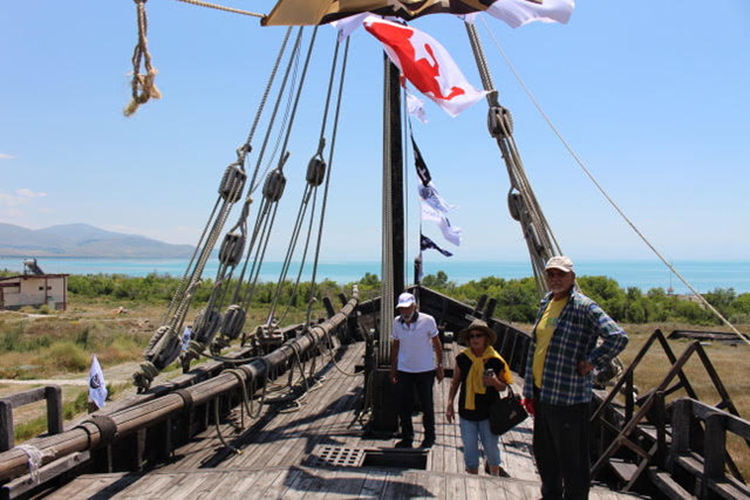

To learn seamanship Balayan traveled to Georgia where he enrolled in school to learn seamanship, receiving his ship captain’s license. Just as there were no experienced 13th c ship builders to learn from, there also were no old salts left to teach sailing a 13th c ship. So the Cilicia’s crew spent two years learning to sail the ship on Lake Sevan. Finally they gingerly towed the ship on a specially built trailer through the mountains of Armenia and Georgia to the Black Sea, setting sail under an Armenian flag.
Initial financing for this project was from friends. Later, when success appeared on the horizon other donors came forth to help. The ship had little modern equipment except those items required by maritime law – a small engine and a radio.
In 2004, flying an Armenian flag and starting from the Black Sea with a crew of 12, the Cilicia ship visited the ports that a 13th c Armenian merchant ship would have visited, including the Armenian Cilician ports of Ayas, Korikos, and Alexendretta (in current day Turkey), then Syria and Lebanon as well as other ports on the Mediterranean. Later it was on to Europe and Russia. They did not sail during the winter months. Turkey offered no impediment to visiting ports in Turkey. Off the coast of Syria a coast guard ship quietly approached during the nighttime darkness, then lit its searchlights. The Syrians were cautioned to take care that this was a fragile wooden ship and to avoid potentially damaging contact with their metal ship. Two Syrian officers boarded the ship. Only the Syrian captain spoke English (the international maritime language). They toured the ship and were quite impressed. In Greece the Cilicia ship put into port after surviving a severe storm resulting in damage to the ship’s rudders. Greek officials were impressed that the ship survived the storm and was able to make it to port – a testimony to the seamanship of the Armenian crew and the seaworthiness of the ship.
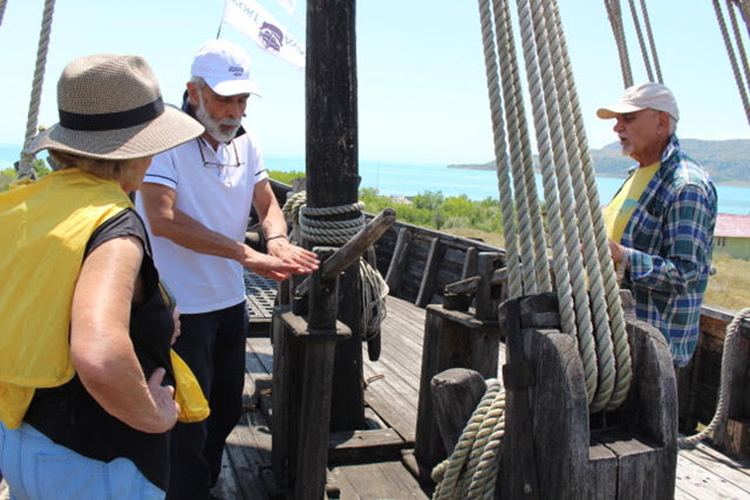

During three years the Cilicia traveled 15,000 nautical miles. After visiting European ports and Russia, it sailed down Russian rivers entering the Black Sea. The ship was then transported back to Armenia’s Lake Sevan, having visited 25 countries and 63 ports.
The ship is currently out of the water, at home in Armenia’s Port Ayas, near the Artinash peninsula on the coast of Lake Sevan. It needs some repairs due to exposure to the hot sun. As Balayan stated, if the ship stayed in the water, it would not last more than 10-20 years. Current plans include the construction of a new home for the ship, a maritime museum in Yerevan near Yerevan Lake where the ship together with Armenian maritime history will be on display. Classes in sailing as well as other activities will be offered. The museum is planned to have a controlled environment, which will help preserve the ship and minimize maintenance. The ship will be visible from outside the museum, hopefully attracting visitors. The establishment of a new museum featuring the Cilicia, as well as other aspects of Armenian nautical history, will be a major addition to Armenia’s cultural and historical attractions. It will encourage further interest in the largely unknown field of Armenian nautical history.
A number of non-Armenians who visited the Cilicia during its journey have offered support, as has the city of Yerevan. Land has been designated for the museum’s construction though this process has not yet been finalized. Positive discussions have been held with relevant Armenian ministries and with Yerevan authorities. There is a sponsor for funding this project though it is unclear if this will cover the complete cost of the museum.
There is a great deal of information about the Cilicia ship on-line, including videos. Simply search for “Cilicia Armenian Ship”.

